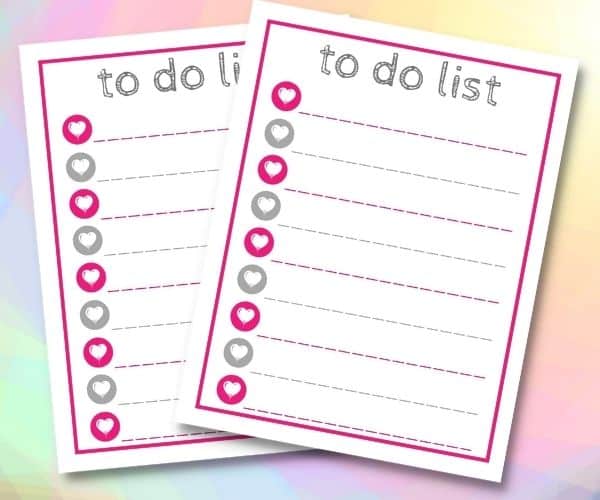How to Create a Realistic To-Do List That Works
This post may contain affiliate links. Please read our disclosure policy.
Learn how to create a realistic to-do list that boosts productivity and reduces stress. Discover practical tips for prioritizing tasks, managing time, and getting more done daily!

We all have the same twenty-four hours in a day, but it often feels like some people use them better than others. It can be frustrating to think that the world’s wealthiest or most successful individuals operate on the same clock as we do.
The secret isn’t a team of assistants handling everything for them—it’s how they plan and organize their time. A realistic to-do list is a powerful tool to help you get things done without feeling overwhelmed. Let’s dive into how you can create one that works for you.
1. Assess How Your Time Is Spent
Before making your list, think about how your hours are currently distributed. Most people spend about:
- 8 hours sleeping
- 1–2 hours on meals
- A few hours on non-negotiable activities like commuting, childcare, or errands
Instead of trying to cram every waking moment with tasks, identify the time you actually have available for focused work. Your to-do list should fit into these realistic time blocks, not an idealized schedule.
2. Write Your To-Do List the Night Before
Planning your day the night before gives you a clear idea of what to expect and sets you up for success. When you know what needs to be done, you can:
- Adjust your wake-up time if needed
- Mentally prepare for your tasks
- Start your day with purpose instead of scrambling to figure things out
For example, if you know you need extra time to prep for an early meeting, setting that intention the night before eliminates the morning rush.
3. Prioritize Tasks Wisely
Not all tasks are created equal. Use a system like the Eisenhower Matrix to decide what goes on your list:
- Urgent and important: Handle these first.
- Important but not urgent: Schedule time for these.
- Urgent but not important: Delegate if possible.
- Neither urgent nor important: Consider skipping these.
Focus on 3–5 high-priority tasks each day. Trying to do too much leads to frustration, not productivity.
4. Break Down Larger Tasks
Big tasks can feel overwhelming and lead to procrastination. Break them into smaller, manageable steps.
For example, instead of “Clean the house,” try:
- Clear the kitchen counters (15 minutes)
- Vacuum the living room (20 minutes)
Smaller steps make progress more achievable and motivate you to keep going.
5. Use Time Blocks Instead of Task Lists
Rather than assigning specific times to individual tasks, block off chunks of time for certain types of activities. For example:
- 9:00–10:30 AM: Work on a presentation
- 10:30–11:00 AM: Answer emails
- 11:00 AM–12:30 PM: Client meetings
This approach gives you the flexibility to focus without the pressure of sticking to an overly rigid schedule.
6. Be Generous with Time Estimates
Tasks often take longer than expected. Plan extra time for each activity to avoid stress. If you’re unsure how long something takes, use a timer to track it. For example:
- Think getting ready in the morning takes 20 minutes? Track it and find out it’s closer to 30. Plan accordingly!
Overestimating your time needs means you’ll end the day with fewer surprises and more room to breathe.
7. Set Up Routines for Success
Routines make productivity effortless. Establish morning, evening, and task-specific routines to reduce decision fatigue. For example:
- Morning routine: 15 minutes of journaling, a quick workout, and a healthy breakfast.
- Evening routine: Prepare your to-do list, tidy your workspace, and relax with a book.
With routines in place, you’ll save time and mental energy every day.
8. Review and Reflect Daily
Set aside 5–10 minutes at the end of the day to review your progress:
- What tasks did you complete?
- What took longer than expected?
- What needs to be carried over to tomorrow’s list?
This reflection helps you refine your time estimates and improve future planning.
9. Use the Right Tools
Find tools that work for your style, whether digital or paper:
- Apps: Todoist, Trello, Notion
- Physical planners: Bullet journals, daily planners
Experiment to see what keeps you organized and motivated.
10. Avoid Overloading Your List
A to-do list is not a wish list. Be realistic about what you can achieve in a day. If it feels overwhelming, ask yourself:
- Can I delegate this task?
- Does this truly need to be done today?
- Is this aligned with my priorities?
Sometimes, the most productive thing you can do is say no to less important demands.
Creating a realistic to-do list is more than jotting down tasks—it’s about setting yourself up for success. Understanding how you spend your time, prioritizing wisely, and being flexible with your schedule will reduce stress and accomplish what matters most.
Start implementing these tips today, and you’ll be well on your way to a more productive and balanced life!








